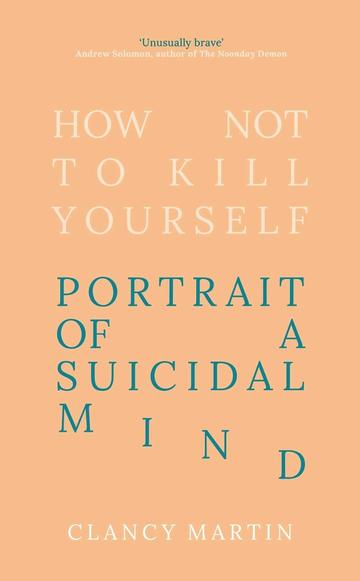How Not to Kill Yourself: Portrait of a Suicidal Mind by Clancy Martin
How Not To Kill Yourself: Portrait of a Suicidal Mind by Clancy Martin (Oneworld, 2023)

[This book review discusses suicide throughout; it describes some suicidal feelings but does not describe suicide or self-harm methods. You do not have to read this review if you don’t want to. Please take breaks if you need to while reading, and do something you enjoy (maybe in the gaps between the paragraphs!).]
In this brave book, Clancy Martin writes openly about his several suicide attempts. How Not to Kill Yourself is a personal story, dealing with Martin’s family, Buddhism, and his professional life in academia (and previously, selling jewellery). As it is the story of someone who is curious about other people and their motivations, How Not to Kill Yourself includes quotations, advice, and reflections from a variety of people from centuries in the past and from the present day. The book is written for those who know what it’s like to feel suicidal, to attempt suicide, to live with the grief of a loved one’s suicide. Martin encourages us to acknowledge that we all suffer, and emphasises that beating ourselves up for suffering needlessly causes ourselves more suffering: we are not bad people because we are in pain (p.205).
In the main body of the book, Martin relates his own story, drawing on texts he has read and conversations he has had about suicide. This is followed by a shorter section called ‘Tools for Crisis’, which includes websites and ideas of things to think and do in a crisis whether we are supporting ourselves or other people. One piece of advice, which Martin repeats, and which you may recognise, is to agree with oneself to wait some time (a week, 48 hours, a day) before acting on suicidal thoughts; usually after some time the strong suicidal crisis will have passed and/or the suicidal person will have received some help. Finally, he includes a set of interviews with people who have a deep understanding of suicide: the Buddhist scholar and teacher Dzongsar Jamyang Kyentse Rinpoche, Dese’Rae L. Stage whose website Live Through This documents lived experiences of suicidality, the author Andrew Solomon, and John Draper ‘the suicide helpline guy’ in the US.
I found quite striking Martin’s key theme of attempting suicide as a habit or addiction. He puts this in context of his own experiences of living with addiction and writes,
‘thinking about killing oneself and addictive thinking have a lot more in common than is normally recognised. They may even be different variations of the same fundamental kind of thinking. With this model—which, granted, may only characterise one kind of suicidal inclination—wanting to kill yourself is like an extreme version of the relief you find after drinking a few glasses of wine, and the pungent smell of yourself seems to drift off into the breeze’ (65)
Martin also describes how philosophical ‘and sometimes unphilosophical’ arguments can change our ‘daily thinking’ and help break and challenge all manner of habits, including the habits of seeing suicide as a solution to pain and of attempting suicide (p.127).
A warning: How Not to Kill Yourself does not just discuss suicidal feelings. It describes suicide and self-harm methods with some frequency which is something many people want to avoid reading about.
Staff and students in our neurodiverse community might find this book particularly interesting given that the author is an academic talking frankly about addiction, suicide, and emotion more generally. I felt that though the book sometimes reads like a general explanation of why people are suicidal and how suicidal people feel—speaking with a ‘we’ or offering to say why ‘people’ behave the way they do—I read it more as a collection of individual stories in conversation with each other. Several readers might notice that they have a different experience of being suicidal to that which is described in How Not to Kill Yourself and that is a very valuable realisation. I can't fully imagine what it must have taken for Martin to be able to write this book, spending hours remembering and working to describe some of the most difficult feelings and experiences a human being can have. Hearing one person’s story of their suicidality can give us courage to (re-)tell our own, and to hear more stories about suicide. I’m glad when people are in gentle, non-judgemental conversation about suicide because this can have a very positive effect on suicidal people; How Not to Kill Yourself is part of this conversation on suicide which I hope others will join.
Hello at the end of this review, how are you?
What can you do to look after yourself today?
Do you want to talk to someone after it?
Samaritans: Call 116 123 for free from the UK and ROI, 24/7
Oxfordshire Mind: oxfordshiremind.org.uk
Oxford Student Counselling Service: ox.ac.uk/students/welfare/counselling?wssl=1
Oxford Staff Counselling Service and EAP: occupationalhealth.web.ox.ac.uk/staff-counselling-service
Find a Therapist: bacp.co.uk/about-therapy/using-our-therapist-directory/
Dr. Laura Seymour is a stipendiary lecturer in English. She researches neurodiversity in early modern European writing, and neurodiversity-inclusive pedagogy. She is currently finishing Shakespeare and Neurodiversity (Cambridge University Press, 2024), a guide to teaching Shakespeare in a neurodiversity-inclusive way. She has taught in higher education for a decade on a variety of fixed-term and precarious contracts. Another forthcoming publication is 'Quintessence of Dust: Centring Lived Experience of Neurodivergence, Mental Illness, and Suicidal Ideation in Reading Shakespeare's Hamlet' in Avi Mendelson and Leslie Dunn, eds, Shakespeare's Madnesses (Palgrave, 2024), part of the British Academy-funded project New Understandings of Hamlet.



